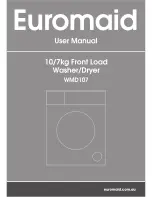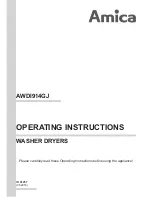
GB
5.4 REFRIGERATING COMPRESSOR
The refrigeration compressor is the pump in the system, gas coming from the evaporator (low pressure side)
is compressed up to the condensation pressure (high pressure side). The compressors utilized are
manufactured by leading manufacturers and are designed for applications where high compression ratios
and wide temperature changes are present. The hermetically sealed construction is perfectly gas tight,
ensuring high-energy efficiency and long, useful life. Dumping springs support the pumping unit in order to
reduce the acoustic emission and the vibration diffusion. The aspirated refrigeration gas, flowing through the
coils before reaching the compression cylinders cools the electric motor. The thermal protection protects the
compressor from over heating and over currents. The protection is automatically restored as soon as the
nominal temperature conditions are reached.
5.5 CONDENSER
The condenser is the component in which the gas coming from the compressor is cooled down and
condensed becoming a liquid. Mechanically, a serpentine copper tubing circuit (with the gas flowing inside)
is encapsulated in an aluminum fin package. The cooling operation occurs via a high efficiency fan, creating
airflow within the dryer, moving air through the fin package. It’s mandatory that the ambient air temperature
does not exceed the nominal values. It is also important
TO KEEP THE CONDENSER UNIT FREE FROM
DUST AND OTHER IMPURITIES
5.6 FILTER DRIER
Traces of humidity and slag can accumulate inside the refrigerating circuit. Long periods of use can also
produce sludge. This can limit the lubrication efficiency of the compressor and clog the expansion valve or
capillary tube. The function of the Filter Drier, located before the capillary tubing, is to eliminate any
impurities from circulating through the system.
5.7 CAPILLARY TUBE
It consists of a piece of reduced cross section copper tubing located between the capacitor and the
evaporator to form a throttling against the flow of the refrigerating fluid. This throttling creates a pressure
drop, which is a function of the temperature to be reached within the evaporator: the lower the capillary tube
outlet pressure, the lower the evaporation temperature. The length and the diameter of the capillary tubing
are accurately sized with the performance to be reached by the dryer; no maintenance/adjustment
operations are necessary.
5.8 ALU-DRY MODULE
The heat exchanger module houses the air-to-air, the air-to-refrigerant heat exchangers and the demister type
condensate separator. The counter flow of compressed air in the air-to-air heat exchanger ensures maximum heat
transfer. The generous cross section of flow channel within the heat exchanger module leads to low velocities and
reduced power requirements. The generous dimensions of the air-to-refrigerant heat exchanger plus the counter
flow gas flow allows full and complete evaporation of the refrigerant (preventing liquid return to the compressor).
The high efficiency condensate separator is located within the heat exchanger module. No maintenance is required
and the coalescing effect results in a high degree of moisture separation.
5.9 HOT GAS BY-PASS VALVE
This valve injects part of the hot gas (taken from the discharge side of the compressor) in the pipe between
the evaporator and the suction side of the compressor, keeping the evaporation temperature/pressure
constant at approx. +2 °C. This injection prevents the formation of ice inside the dryer evaporator at every
load condition.
ADJUSTMENT
The hot gas by-pass valve is adjusted during the manufacturing
testing phase. As a rule no adjustment is required; anyway if it is
necessary the operation must be carried out by an experienced
refrigeration engineer.
WARNING : the use of ¼” Schrader service valves must be justified
by a real malfunction of the refrigeration system. Each time a
pressure gauge is connected, a part of refrigerant is exhausted.
Without compressed air flow through the dryer, rotate the adjusting
screw (position A on the drawing) until the following value is reached:
Hot gas setting (R134.a) : pressure 2.0 barg (+0.1 / -0 bar)
Hot gas setting (R407C) : pressure 4.7 barg (+0.1 / -0 bar)
A
4 mm
5/32 in.
+
-
V
L
Y
0
0
0
2
Summary of Contents for DK 2300
Page 36: ...7 1 1 DK 2300 DK 3000...
Page 37: ...7 1 2 DK 2300 DK 3000...












































